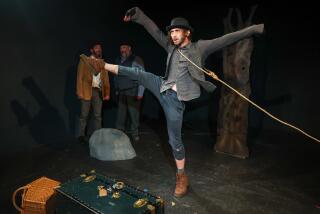Great Escape Artists: Psychoanalyzing Houdini--and the Rest of Us
It is an oddity of our time that, while psychoanalysis is widely derided by both highbrows and populists, its mutant stepchild--the therapeutic culture--grows monstrously stronger year by year. The therapeutic culture flourishes everywhere: in womenâs (and now menâs) magazines, talk shows, advertisements, nursery schools and universities, even the highest levels of government (best example: Bill âI Feel Your Painâ Clinton). Weepy, bombastic and strenuously optimistic, it exalts sentimental emotion, catharsis and self-esteem. The therapeutic culture is to psychoanalysis what Andrew Lloyd Webber is to Brecht. But across the Atlantic, psychoanalysis has not been quite so de-formed, and Adam Phillips is probably its best-known British exponent, at least for the layperson. In a tsunami of witty, stylish books and literary essays (Phillips is terrifyingly prolific), he has used psychoanalysis not as an ideological straitjacket but as a prism through which to ask, and even sometimes answer, questions about what it might mean to be human. His questions--and answers--tend to be highly paradoxical, counterintuitive, ironic and playful. But he also repeatedly returns to the old-fashioned categorical imperatives: freedom, pleasure, knowledge and good faith. For Phillips, I suspect, neurosis is âbadâ not because it is pathological, but because it gets in the way of those other, better things.
In âHoudiniâs Box,â Phillips recounts the story of the early 20th century magician (the son, Phillips tells us, of a Hungarian rabbi) who achieved world fame for his death-defying escapes. Phillips is not really interested in magic tricks but, rather, in Houdini as a cultural icon. Houdiniâs stunts were fantastically, indeed sometimes grotesquely, dangerous, but they were in no sense transformative; thus, Phillips writes, âHoudini was a new modern kind of hero because his aim was to be essentially unchanged by his ordeal; he didnât learn anything new in doing what he did, he confirmed his previously acquired knowledge.â
The author repeatedly compares Houdiniâs craft with a less savory one: âHoudini was to escapism what pornography is to sex; dazzlingly literal, demanding nothing of the consumer but his money and his fascination.â And he contemplates Houdiniâs fans, focusing on the unconscious meanings of their voyeurism: âHe told the audience about their own secret violence; he told them that what they wanted, what gave them such wild pleasure, was flirting with his own death. He had given everything for their amusement, for their innocent sadistic pleasure.â
Mainly, though, Phillips is interested in us--that is, in ordinary men and women--and the ways in which we too are always escaping from our selves, our knowledge, our certainties and our doubts. For Phillips, flight can be a form of obfuscation--or, alternately, of wisdom, if we only can be brave enough to investigate its meanings.
He writes, âWe are all too familiar with ourselves as escape artists. Knowingly or otherwise we map our lives ... according to our aversions.
Phillips is highly insightful (and sometimes quite funny) in accounts of psychoanalytic sessions he has conducted with his patients that are interspersed with chapters on Houdini. But these chapters are somewhat disconcerting, as if he were advertising himself. And that is unnecessary, for his perceptiveness is revealed, organically and far more convincingly, in the rest of âHoudiniâs Box,â where the author limns the ways in which escape has become âa prosthetic device of the imagination.â
More to Read
The biggest entertainment stories
Get our big stories about Hollywood, film, television, music, arts, culture and more right in your inbox as soon as they publish.
You may occasionally receive promotional content from the Los Angeles Times.










